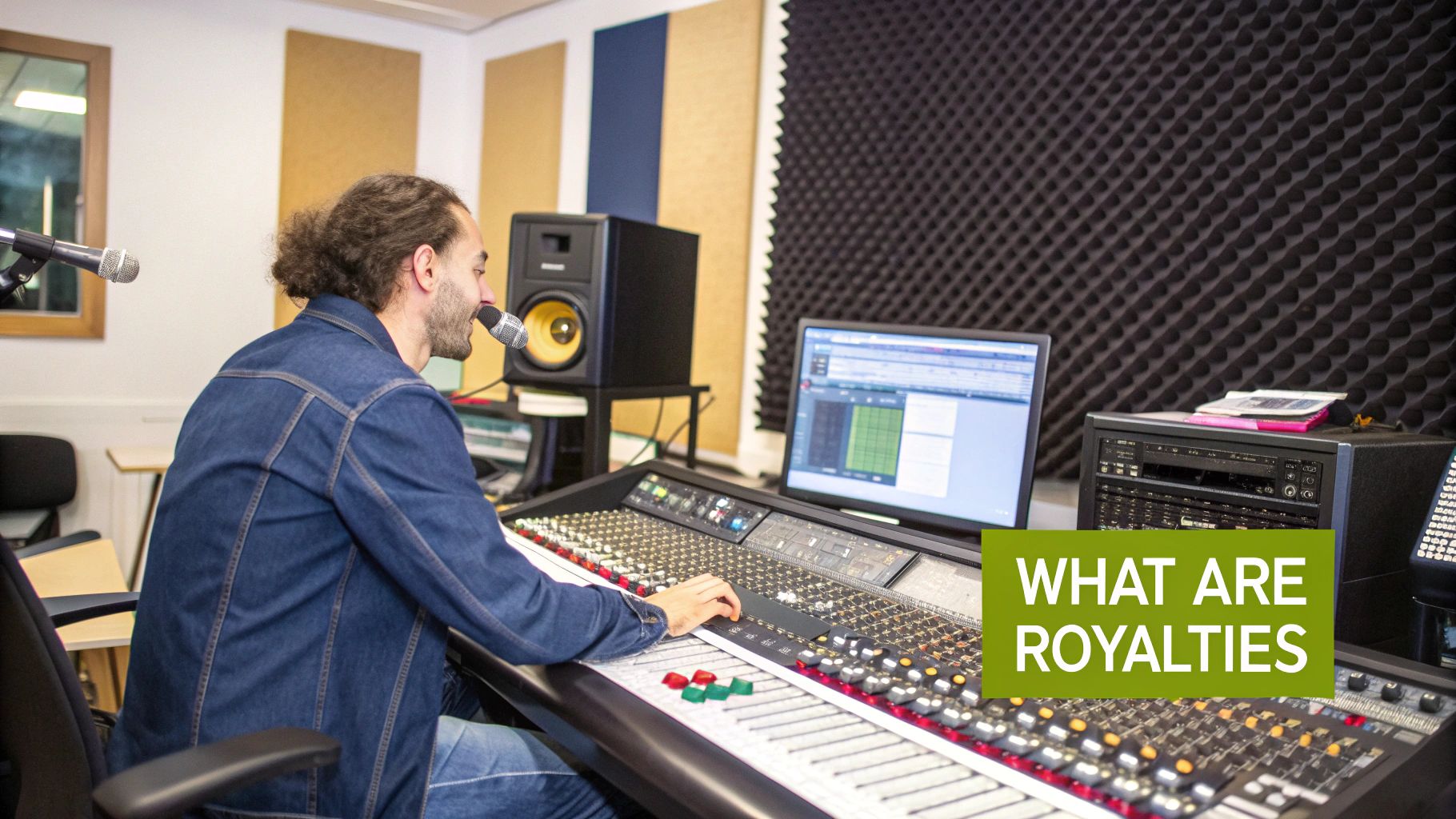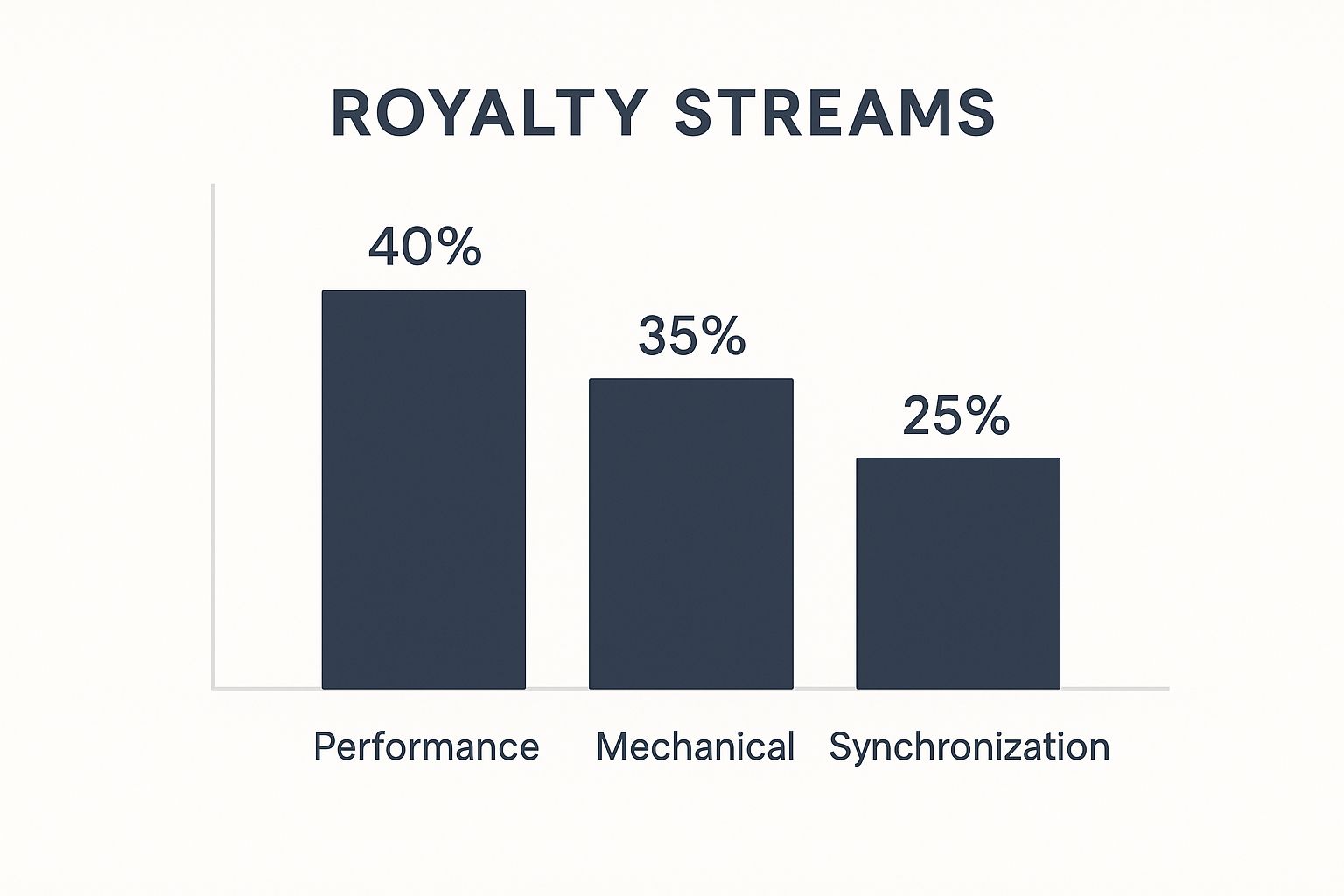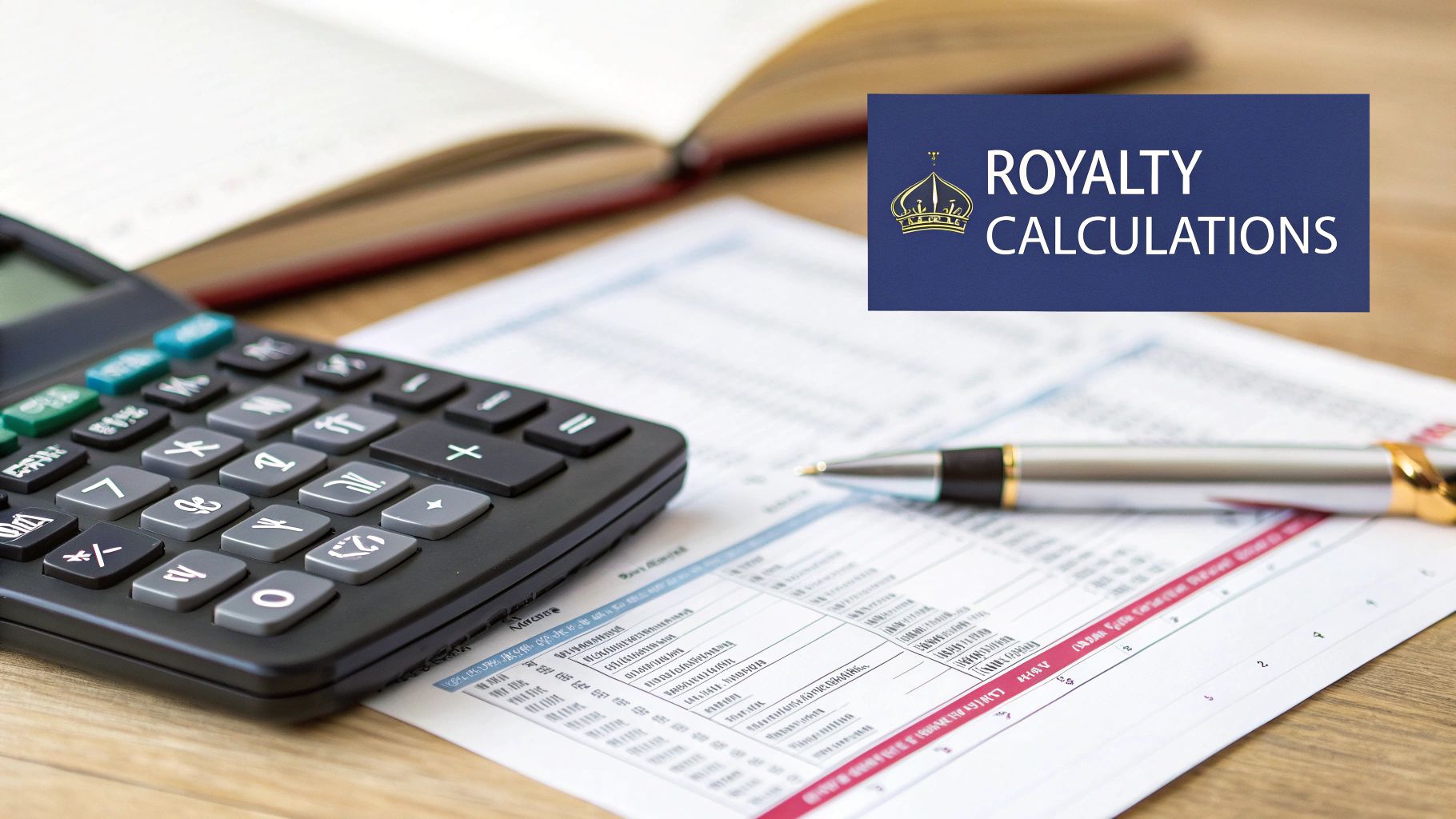Untangling the Messy World of Music Royalties

Let me be upfront: music royalties are a mess. I've spent years (literally, not an exaggeration) at Cordero Law helping musicians navigate this labyrinthine system. Honestly, it feels deliberately designed to confuse creators. The basic concept is simple: when your music is used, you get paid. Simple, right? Wrong.
So Many Royalties, So Little Time
It gets wildly complicated very quickly. There are mechanical royalties, performance royalties, and neighboring rights, just to name a few. Each flows through different pipelines that seem to actively avoid interacting with each other. It's insane. I’ve seen artists lose out on thousands simply because they weren’t aware of these different income streams.
The Real Deal, Not the Textbook Version
I could give you the sanitized textbook explanation (the kind you'd get in law school), but what's the point? At Cordero Law, we focus on practical advice. I'll break down what’s actually happening with your money, why the system evolved this way (hint: it wasn't to benefit the artist), and, most importantly, how to ensure you’re collecting every cent you’re owed. Industry veterans like to gatekeep this information, but at Cordero, we're all about transparency.
The Growth of Global Music Royalties
This isn't small change we're talking about. In 2023, global music royalties reached €11.7 billion, a 7.6% increase from the previous year. This jump is largely due to the rise of streaming services. Spotify alone paid out $10 billion to the music industry in 2024! More than any single company has ever contributed. That's a game-changer, demonstrating how crucial streaming has become to the music industry's bottom line. Discover more insights about the global music royalty market here.
Why This Matters (A Lot)
I get genuinely frustrated seeing talented artists get the short end of the stick in this convoluted system. This stuff gets me fired up. My goal – our goal at Cordero Law – is to empower you. Knowledge is power. This isn’t just about understanding legal jargon; it’s about taking control of your career and your finances. (And maybe sticking it to “the man” a little bit, too.)
Streaming: Where's My Million-Stream Payday?

The infographic above illustrates how royalty streams are divided into performance, mechanical, and synchronization royalties. Performance royalties represent the largest portion, followed by mechanical royalties. While sync licensing constitutes a smaller percentage, it can still offer significant payouts.
At Cordero Law, we often encounter artists thrilled about their 100,000 streams, only to be disappointed by their royalty statement. The common refrain? "That's it? Thirty-seven dollars?!" The streaming economy has its quirks. The math often defies expectations.
The Per-Stream Myth (and Why It Matters)
Let's debunk the myth of the "per-stream rate." While you'll encounter figures – often fractions of a penny – these can be misleading. There isn't one fixed per-stream rate.
- Platform Variability: Spotify pays differently from Apple Music, and so on. These rates can also change.
- Deal Impact: Your distribution agreement and any label deals influence your share.
- Free vs. Paid: Streams from free accounts generate less revenue than paid subscriptions.
The per-stream rate is a starting point, not the whole story. While crucial, it's only one piece of a complex puzzle. The global reach of streaming platforms connects artists with diverse fan bases. Research shows artists earning over $100,000 in royalties create music in over 50 languages, while even million-dollar earners work in 17 languages. For more detail, see this Spotify research. Streaming has undeniably transformed the music landscape, opening doors for artists worldwide.
Following the Money (It's a Winding Road)
What happens financially when someone streams your track? Imagine a listener in Japan plays your latest single:
- Platform Collection: The streaming service collects revenue, either from subscriptions or advertising.
- Distribution: The platform takes its cut, then distributes the remaining funds to rights holders, including record labels, distributors, publishers, and eventually, the artist.
- PRO Involvement: A portion goes to your Performance Rights Organization (PRO) for performance royalties, a key component of streaming revenue.
- Mechanical Royalties: Mechanical royalties for song reproduction are also generated, often going to your publisher or a mechanical rights organization like the MLC.
Algorithms and Playlists: Not Always a Meritocracy
Streaming service algorithms and curated playlists aren't always objective. They often prioritize major label artists. Understanding these algorithms and how to work within the system is crucial for maximizing streaming revenue. This goes beyond buying fake streams; it involves creating music the algorithms favor.
Streaming is the present and future of music, despite its complexities. Success isn't just about million-stream paydays, but about understanding the system and playing the game effectively. Cordero Law can help you navigate this intricate landscape and ensure you receive your due.
To help illustrate the varying royalty rates and payment structures across different platforms, let's take a look at the table below:
Streaming Platform Royalty Comparison
A breakdown of estimated per-stream royalty rates across major streaming platforms and how they translate to real earnings
| Platform | Estimated Royalty Rate | Streams Needed for $1,000 | Payment Timeline | Special Notes |
|---|---|---|---|---|
| Spotify | $0.003 – $0.005 per stream | 200,000 – 333,333 | Monthly | Rates can vary based on listener location and subscription type. |
| Apple Music | $0.01 per stream | 100,000 | Monthly | Generally considered to have a higher per-stream rate. |
| Amazon Music | $0.004 – $0.008 per stream | 125,000 – 250,000 | Monthly | Offers various tiers with different royalty rates. |
| YouTube Music | $0.00069 per stream | ~1,449,275 | Monthly | Rates are significantly lower due to the ad-supported model. |
| Tidal | $0.01 per stream | 100,000 | Monthly | Known for higher payouts but a smaller user base. |
As you can see, each platform has its own royalty structure and payment schedule. It's important to research and understand these differences to optimize your earnings. While Tidal and Apple Music might offer higher per-stream rates, Spotify's larger user base can potentially lead to greater overall earnings. Consider these factors when choosing where to distribute your music.
The PRO Move: Performance Royalties You're Missing

I'm constantly amazed by how many musicians are leaving money on the table. There's a significant revenue stream many artists are completely unaware of: performance royalties. This oversight can cost them thousands of dollars, potentially even more.
Getting Paid When Your Music Plays (It’s Not Magic)
Think about it. Every time your song plays on the radio, in a bar, at a festival, or even as background music in a restaurant, you're owed money. It's a fundamental right, but there's a crucial step: you have to be registered with a Performance Rights Organization (PRO).
ASCAP, BMI, SESAC… Seriously?
The three main PROs are ASCAP, BMI, and SESAC. While their marketing might suggest significant differences, the core function is the same: collecting performance royalties. Getting registered with any of them is the essential first step. Perhaps even more crucial is understanding what these organizations do (and don't do) for you.
Real Talk: The $12,000 Surprise
I once had a client, a talented musician, who had $12,000 in unclaimed performance royalties. Twelve thousand dollars just waiting to be claimed! This happened because nobody had explained the PRO system to him. He came to me, concerned about streaming revenue, and during our conversation, we unearthed this hidden treasure. It's unbelievable how much money goes unclaimed simply due to a lack of information.
Paperwork, Ugh, But Worth It
Yes, the paperwork involved in registering with a PRO can be tedious. But trust me, it's worth it. I'll break down the process in future posts, covering:
- What you need to do, step-by-step.
- How international collection works.
- When it might make sense to hire an administrator to handle the complexities.
The Missing Piece of the Puzzle: International Royalties
International royalty collection adds another layer of complexity. Different countries have different collection societies, making managing it all yourself quite a challenge. We'll discuss how to navigate this in later posts, but for now, know that with a solid plan, it's definitely manageable.
Why This Matters (More Than You Think)
I'm passionate about helping musicians understand and access all their revenue streams. Performance royalties are often overlooked, yet they are a vital part of a musician's income. Especially in today's evolving music industry, artists need to be business-minded. My mission is to empower musicians with the knowledge they need to thrive financially and build a sustainable career.
Publishing & Mechanical Royalties: The Big Money Grab
If you've signed away your publishing without understanding what it is…well, let's just say we need to have a chat. Publishing is where the significant income lies in the music industry, and many artists are unaware of its importance. Honestly, many of my clients at Cordero Law have only a vague understanding of how it all works.
Mechanical Royalties: Every. Single. Copy.
Mechanical royalties are earned every time your music is reproduced. This includes vinyl, CDs, digital downloads, and even streams. Yes, even streams generate both performance and mechanical royalties. They just come through different avenues. (Because music industry logic, right?)
Publishing: The 50/50 Split (And Why It Matters)
Publishing refers to your composition – the melody, lyrics, the essence of the song itself. Someone reproduces or publicly performs your song, and they pay a royalty for it. Sounds straightforward, but it's a complex system. Songwriters typically split these royalties with publishers, often in a 50/50 split. There are two main types of publishers:
- Publishing Administrator: They collect your publishing royalties, take a cut (usually 15-20%), and send you the remainder. They aren't actively pitching your music for synchronization deals.
- Full Publisher: They take a more hands-on approach, potentially offering an advance, actively pitching your music for sync placements, and connecting you with other songwriters. However, they generally take at least half of your publishing royalties – a considerably higher percentage than an administrator. This is a decision that requires careful thought.
Decoding the MLC, HFA, and Music Reports
The Mechanical Licensing Collective (MLC) is a whole other entity. Established to streamline mechanical royalty payments in the US, they currently hold millions in unmatched royalties. Over $500 million, as of my last check. Seriously. Global recorded music revenues hit $29.6 billion in 2024, largely thanks to streaming, as detailed here. That money is potentially yours, waiting to be claimed. Head over to The MLC website and ensure you're registered!
Before the MLC, the Harry Fox Agency (HFA) and Music Reports handled mechanical licensing for physical formats and downloads. The MLC largely absorbed HFA’s role in digital music licensing. I’ll delve deeper into the MLC vs. HFA distinction in a future post, but for now, know that the MLC is essential for mechanicals in the streaming world.
What About Artists?
You might be wondering, "Doesn't someone else get paid?" You’re probably thinking about the artist. Remember: publishing and mechanical royalties are for the songwriter. The artist (the performer) receives separate payments for their streams from streaming revenue.
Why All This Matters (Like, A Lot)
I've witnessed too many artists lose out on publishing deals. Not knowing your rights is like entering a casino without a full grasp of the rules. Understanding publishing is arguably the most important financial decision you’ll make in your music career. Even if you think you're not a "big deal," every penny counts, and your future self will thank you. Seriously, take action on your publishing. Register on the MLC, review your deals, and then double-check your MLC registration!
Sync Licensing: Your Ticket to Actual Money

Let's be honest. For most independent artists, sync licensing offers significantly greater earning potential than streaming. One strategically placed song in a TV show, commercial, or video game can easily generate more revenue than a million streams.
I'm talking serious money. I once had a smaller artist client land a national ad spot. The single payout from that one placement exceeded their entire previous year's earnings. No exaggeration. However, the sync world operates differently. It has its own unique ecosystem, terminology, and expectations.
So, What Even Is Sync?
Synchronization, or "sync," refers to pairing your music with visual media. Think about:
- Commercials (especially those big-budget ones)
- TV Shows (background music, theme songs, everything in between)
- Films (from indie projects to major blockbusters)
- Video Games (setting the atmosphere and building intensity)
- Even corporate training videos
It's all about enhancing visuals with the perfect soundtrack.
What Music Supervisors Want
What do music supervisors (the people selecting the music) look for? Quality is important, of course. But it's more complex than that:
Production Quality: This is paramount. Your mix must be pristine and broadcast-ready – crisp, clear, and professional. No exceptions.
Emotional Impact: Music supervisors seek tracks that evoke specific emotions – excitement, sadness, tension – whatever suits the scene. They need music that tells a story and enhances the visual narrative.
Clearances and Metadata: This is where the technical aspects come into play. You absolutely must have all your legal matters in order. Who owns the publishing rights? Who owns the master recording? Is it registered with your Performing Rights Organization (PRO)? Inaccurate or incomplete metadata can quickly derail a deal. Understanding the paperwork is essential. You can read more about contract management best practices.
How Much Can You Make? (The Fun Part)
Sync licensing fees can range from a few hundred dollars for a smaller placement to six-figure deals (yes, really!). Several factors influence the amount:
Usage: How prominently is the song featured? What is the duration of the usage? Where will it be used (national TV versus a local web ad)?
Exclusivity: Is the license exclusive to that particular project, or can you license the track elsewhere? Exclusive deals generally command higher fees.
Negotiation: A skilled entertainment lawyer can significantly impact the outcome. I’ve helped clients secure far better deals than they initially thought possible.
Getting Your Music Sync-Ready
The barrier to entry for sync licensing is lower than many artists believe. You don't necessarily need a major publisher or label (though they can certainly be helpful).
What you do need is "sync-ready" music. This means high-quality production, accurate metadata, and a solid understanding of how sync deals work. Hopefully, you're starting to grasp that now. More on this later.
Retitiling: Don't Even
One final point: retitiling (creating multiple versions of your tracks with slightly different names) might seem like a clever way to maximize placements. It's not. It's a legal minefield. Trust me – I've cleaned up enough of these messes to know. I'll explain this in more detail soon.
Going Global: International Royalty Collection
If your music is gaining any traction outside your home country, you could be missing out on significant earnings. We're talking potentially thousands, even tens of thousands, depending on your reach. Collecting international royalties can feel overwhelming, but it's crucial for maximizing your income.
International royalty collection can be a complex process. Each country has its own performing rights organizations (PROs), rules, and payout schedules. This fragmented system can be challenging to navigate, especially for independent artists.
Why International Royalties Are a Mess
It’s common for artists to experience success in other countries but never receive the royalties they’ve earned. Why? The current international royalty system wasn't designed for the digital streaming age. It's outdated and can be confusing, making it difficult for artists to collect their earnings.
Getting Your Fair Share (It’s Possible!)
Navigating international royalty collection doesn't have to be a headache. Here's how you can ensure you receive every penny you're owed:
Direct Affiliations: You can directly affiliate with foreign PROs. This involves joining each individual PRO in the territories where your music is played. While time-consuming, this method gives you direct control over your royalty collections.
Services Like Rumblefish: Services such as SESAC's Rumblefish can streamline the process by handling international collection on your behalf. They act as a central point of contact for multiple territories.
Publishers With International Networks: Partnering with publishers who have established international networks can simplify things considerably. They already have the infrastructure and relationships in place to collect royalties from around the world. However, they will take a percentage of your earnings. Carefully review any publishing agreements before signing.
Exchange Rates, Withholding Taxes, and Waiting…and Waiting
International royalty collection also comes with unique challenges:
Exchange Rates: Fluctuating currency values can impact your earnings. The value of a euro, for example, can change relative to the dollar, affecting the final amount you receive.
Withholding Taxes: Countries have different tax laws, and some may withhold taxes from your royalties before you receive them. These withholding taxes can significantly reduce your earnings.
Payment Timelines: Be prepared for delays. International royalty payouts can take months or even longer to process.
To better understand these complexities, let's look at a table summarizing the challenges and their impact:
To provide a clearer picture of the international royalty landscape, let's examine the major collection societies:
International Royalty Collection Societies
| Society | Territory | Types of Royalties Collected | Registration Process | Payment Timeline |
|---|---|---|---|---|
| ASCAP | United States | Performance royalties | ASCAP Website | Quarterly |
| BMI | United States | Performance royalties | BMI Website | Quarterly |
| SESAC | United States | Performance royalties | SESAC Website | Quarterly |
| SOCAN | Canada | Performance royalties | SOCAN Website | Quarterly |
| PRS for Music | United Kingdom | Performance, mechanical, and other royalties | PRS for Music Website | Quarterly |
| GEMA | Germany | Performance and mechanical royalties | GEMA Website | Quarterly |
| SACEM | France | Performance and mechanical royalties | SACEM Website | Quarterly |
| SIAE | Italy | Performance and mechanical royalties | SIAE Website | Quarterly |
| APRA AMCOS | Australia and New Zealand | Performance and mechanical royalties | APRA AMCOS Website | Quarterly |
| JASRAC | Japan | Performance and mechanical royalties | JASRAC Website | Quarterly |
This table provides an overview of key international PROs. Researching the specific societies relevant to your music's reach is essential for effective royalty collection.
Is It Worth the Trouble? (Yes, Probably)
Despite the complexities, pursuing international royalties is often worthwhile. The global music market is vast, and neglecting international revenue could mean missing out on a substantial income stream. With the right approach, these royalties can provide a passive income source for years to come. It may require effort upfront, but establishing a solid international collection strategy is a key component of maximizing your earnings as a musician.
Your Royalty Game Plan: What To Do Tomorrow
Alright, so I just threw a lot of information your way about music royalties. Feeling overwhelmed? That's perfectly understandable. Even I get overwhelmed sometimes, and I work with this stuff every day. The system is outdated, complicated… even frustrating. But now you have a basic understanding of how it works. It’s time to take charge.
Audit Your Current Setup (Like, Right Now)
Seriously. Do this tomorrow. Go through everything. Where are you registered?
- Are you registered with a Performing Rights Organization (PRO)? (ASCAP, BMI, SESAC… choose one!)
- Have you claimed your catalog on every streaming platform? (Spotify, Apple Music, all of them. Yes, even the less popular ones.)
- Are you collecting your mechanical royalties through the MLC? (If not, you’re missing out on potential earnings. Go get what’s yours.)
I know, it sounds tedious. But think of it as a treasure hunt for your missing royalties. It can actually be kind of fun.
Get Some Help (It’s Okay, I Do Too)
There are royalty administration services that can handle all of this for you. They’re worth every penny if you're serious about your music career. My clients at Cordero Law often ask about this, and I'm happy to connect them with recommendations. These services are experts in navigating this complex world, freeing you up to focus on making music.
Are Your Partnerships Actually Working For You?
Is your distributor, publisher, or label truly adding value? Or are they taking a cut of your royalties without providing substantial service? Evaluate your partnerships. Negotiate better terms. Don't be afraid to walk away from a partnership that isn't beneficial. (A good entertainment lawyer can help with this, by the way.) This isn't about being aggressive; it's about valuing your work and ensuring fair compensation. When looking to expand your reach internationally, consider using SEO Localization to reach new audiences.
Build for the Future (aka Don’t Get Screwed Again)
Understanding music royalties isn’t just about collecting those checks. It’s about structuring your entire music business to maximize your earnings from the very beginning. I've seen artists with minimal talent make a lot of money simply because they understood the business side. Talent is important, of course, but business smarts are crucial for long-term success. The most talented artists don't always make it. Sometimes, success is about knowing how the system works.
This whole royalty issue boils down to understanding your rights and making informed decisions about your collaborators. It's not the most glamorous part of being an artist, but it’s absolutely essential. The artists who build lasting careers – the ones who actually make a living doing this – aren’t necessarily the most talented. They’re the ones who understand how to make the business work for them.
Ready to take control of your royalties and build a sustainable music career? Contact Cordero Law today. We can help you navigate the music industry and ensure you receive all the money you deserve. Visit our website to schedule a consultation. Let’s make sure you’re getting paid what you're worth.
